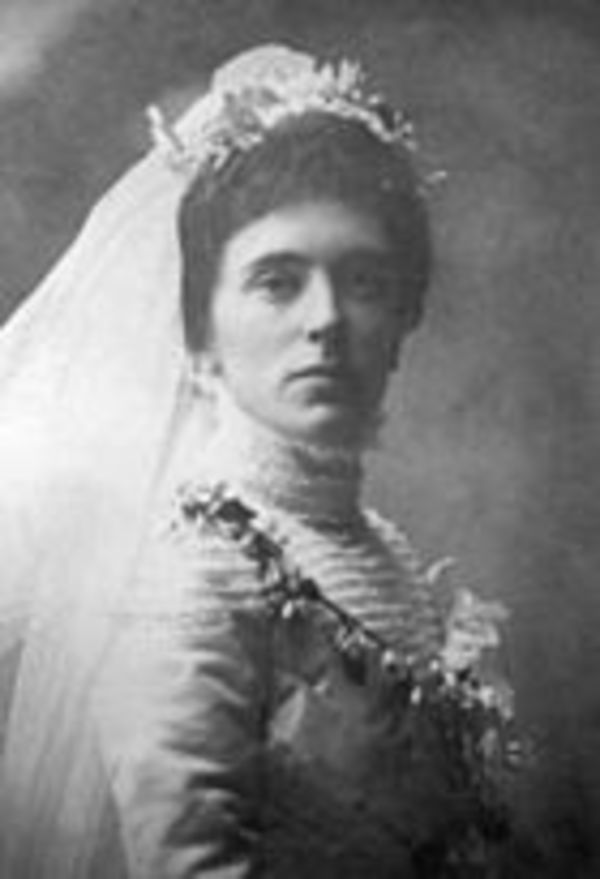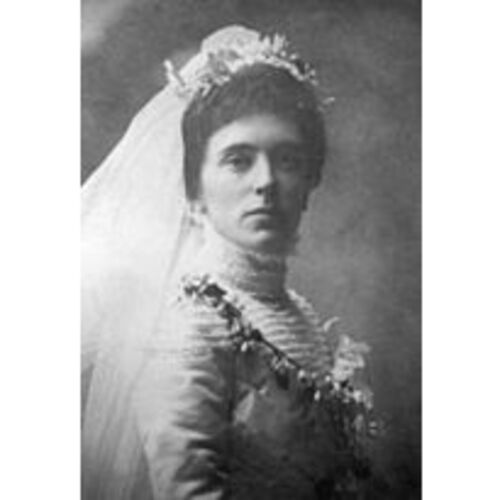
Source: Courtesy of Wikimedia Commons
SHARP, MINNIE BELL (Adney), music teacher and businesswoman; b. 12 Jan. 1865 in Upper Woodstock, N.B., daughter of Francis Peabody Sharp* and Maria Shaw; m. 12 Sept. 1899 Edwin Tappan Adney* in Woodstock, N.B., and they had a son; d. there 11 April 1937.
A daughter of Canada’s foremost pomologist of his era, Minnie Bell Sharp recalled a “glorious” childhood when the whole family took part in maintaining her father’s orchard and market garden. “It seemed to me in those days that I lived in a veritable fairyland,” she would write in 1919, adding that she was a “very precocious and very much indulged child” of seemingly well-to-do parents. As early as age five she would be placed “amid the admiring circle” of her father’s workers to read to them. To encourage the musical gifts she began to demonstrate as an adolescent, her father imported what she later claimed was the province’s first Steinway piano.
When she was 14 Minnie attended the Compton Ladies’ College in Quebec for a year and afterwards completed a term at St Margaret’s Hall, Halifax. About 1883 she began studying voice and keyboard in New York City during the winter months; among her instructors was the Liszt-trained performer and composer William Mason. It was there that she launched her own teaching career. When family financial troubles drew her back home, she supported herself by giving lessons, first in Fredericton and then in Woodstock, where she opened a studio in the spring of 1890. The local press hailed as “recherch[é]” and “severely classical” a concert presented by Sharp, her pupils, and a guest artist from New York City. Sharp was credited with introducing the town to “high class music” and was described as “an accomplished musician” with “the rare ability of most effectively imparting instruction according to the best modern methods.”
In 1893 Sharp moved to British Columbia, taking up residence in Victoria, where she acquired the Conservatory of Music and its pupil list for about $1,200. Advertisements named her as the principal; she and the mostly female teachers offered training in music theory, performance, and languages to about 60 pupils. Newspaper notices of concerts were sympathetic. At this time two themes that would be prominent in Sharp’s life came to the fore: she was seriously in debt, unable to finish paying for the conservatory, and she antagonized her peers with extravagant claims about the superiority of her New York–acquired pedagogical technique.
Sharp would stay in Victoria until 1900, but she returned to Upper Woodstock for several summers to help her siblings with the orchard; she would later describe herself as “the working boss.” During her 1897 visit she was arrested for non-payment of local school taxes. The school trustees acknowledged that they were making an example of her because she “had a bicycle and expensive clothing, and went on expensive trips.” She spent the next 17 days in the Carleton County jail. According to her family, she was ill and hysterical much of the time; according to the jailer, she used the telephone without limit, rode her bicycle, and gave lessons. On the 16th day of her captivity Sharp discovered by reading the relevant provincial statute that, as a non-resident, she was immune from arrest. (The trustees’ lawyers, including Frank Broadstreet Carvell*, admitted that they were unaware of a recent change in the legislation.) She was released the following day and brought a suit against the authorities for false imprisonment, claiming $2,500 in damages. Victorious though she was, the jury awarded her only $1 in damages. When she had that verdict overturned on appeal and a new trial was ordered, the trustees attempted unsuccessfully to take the case to the Supreme Court of Canada. The second trial, in April 1900, was decided in Sharp’s favour; she received $75 in damages, though not before the trustees appealed and lost again.
It was during this three-year period of litigation that Sharp wed the artist, naturalist, and Maliseet ethnologist Tappan Adney, an acquaintance from New York, where she had boarded with his mother. His sister had studied at the conservatory in Victoria, and Sharp exhibited his watercolours there. Running her Woodstock School of Music out of studios in several western New Brunswick villages, Minnie continued to win praise, and her husband soon became famous for his book about the Yukon gold rush, The Klondike stampede (New York and London, 1900). Both assisted with the family orchard. Their only child, Francis Glenn, was born in 1902; he would take music lessons from his mother and go on to be a dance-band leader. In general the Adneys’ 38-year marriage was not a conventional or happy one, and it seems that they may not have lived together for nearly half of it: in the early years Tappan worked in Alaska and New York, and was in the army for a time. In Sharp’s autobiographical newspaper article of 1919, she would avoid all mention of her spouse.
The Sharps’ business had suffered drastic reverses in the 1890s [see Francis Peabody Sharp]. Minnie had “great success” in teaching, as she claimed in 1919, but the Adneys’ earnings were not enough to salvage the family property, which was sold – “stolen,” she declared – in 1904, the year after her father died. By the second decade of the century, when people were still willing to extend credit to her, Minnie was often before the courts for breach of contract with piano wholesalers whose merchandise she had agreed to advertise and sell on commission. Both Robert Sloane Gourlay’s company and Amherst Pianos Limited experienced difficulties in dealing with her; it became necessary to terminate agreements and repossess instruments. There were also legal difficulties with landlords, pupils, and the Woodstock Choral Society, prolonged litigation with creditors over family lands, and cases involving her husband. Apparently alone, she frequently lacked food and firewood. On 27 April 1920 she would use the Woodstock Press to advertise “Mrs. Adney’s Donation Party,” informing the community that “I have waited long for a benefit suited to the magnitude of my services and meritorious work in your behalf.” Three days later, in the Carleton Sentinel, she detailed offerings sought, from food to a “Ford 4 passenger car” to “money that talks.” Her signature was preceded by the words “respectfully and hopefully.”
In 1919 this gifted, troubled, and by now decidedly eccentric woman announced her candidacy for parliament after Carvell resigned his Victoria and Carleton seat. Sharp’s positive motivation was to secure “adequate recompense” for soldiers who had returned from overseas after the end of World War I. The negative force that drew her and many others into the new politics of the post-war period was dissatisfaction with hypocrisy and corruption in politics. The press often referred to her as the “women’s candidate,” but the only vaguely feminist concern she expressed was creating an economy in which children could be reared properly. She had no doubt of her potential: declaring that from her earliest years she had “unlimited faith in my power for great achievements,” she announced, “If I am elected, as I shall be, I shall accomplish the greatest work of all.” When her name failed to be listed on the ballot, she attributed the omission to malversation, but the truth was that women, though allowed to vote in the national election of 1919 [see Sir Robert Laird Borden], could not yet run for the House of Commons. In 1921 she failed to raise the $200 required to file the nomination papers and complained that the Liberal Party should have funded her. The last and best organized of Sharp’s four attempts at elective office was the federal campaign of 1925; her name appeared on the ballot alongside those of James Kidd Flemming* and Thomas Wakem Caldwell. “By their fruits ye shall know them” was her slogan, a characteristically witty allusion to her heritage. Denied the Conservative Party nomination, which went to Flemming, she stood as a “candidate by the grace of God,” and under that banner she won 84 votes.
Not much is known about the Adneys’ circumstances after the mid 1920s. Their son, who was studying to be an actuary at McGill University while continuing to lead a dance band, sent his parents money regularly and repeatedly urged his father to put his mother in an asylum.
In 1930 Sharp had surgery in Montreal to treat a degenerative eye disease. She lived another seven years, near Montreal and in Woodstock, poor, blind, and furious. Yet even in her misery she could affirm that musicians can transcend greed and materialism and finally “scale the heights and walk in God’s gardens in Paradise.”
LAC, R233-34-0, N.B., dist. Carleton (180), subdist. Woodstock (a): 11. Peabody Essex Museum (Salem, Mass.), E 7 (E. Tappan Adney papers), box 21, M. B. Adney to S. True, 16 March 1931. PANB, MC339 (Minnie Bell Adney campaign poster); RS43 (Supreme Court, Court of Appeals records), Adney v. Gourlay, 1914; Adney v. Gourlay, 1915; Amherst Pianos Ltd v. Adney, 1915; RS48 (Supreme Court: causes, 1903–79), Adney v. Gourlay, 1913-105; Amherst Pianos Ltd v. Adney, 1915-4. Carleton Observer (Hartland, N.B.), 24 June, 30 Sept., 28 Oct., 4 Nov. 1925. Carleton Sentinel (Woodstock, N.B.), 16 Sept. 1899; 28 April 1900; 10, 24 Oct. 1919; 30 April 1920; 19, 23 June, 7 July, 16, 27, 28 Oct. 1925. Daily Colonist, 10 Jan. 1896, 31 March 1900. Dispatch (Woodstock), 19, 26 Oct., 5, 9, 12 Nov. 1898; 25 April 1900; 8 July 1914. Press (Woodstock), 5, 12 May 1914; 9 Sept., 7, 21 Oct. 1919; 27 April 1920; 1 Nov., 13 Dec. 1921; 23 June, 7 July, 3, 10 Nov. 1925. Sentinel Press (Woodstock), 8 Aug. 1957. Victoria Daily Times, 5 Sept. 1893. Woodstock Press, 2 June 1886, 26 April 1887, 14 April, 27 Oct. 1890. E. T. Adney, The Sharp family, descendants of Alexander Sharp, of Edinburgh, Scotland, and the province of New Brunswick (Saint John, 1908). Amherst Pianos, Ltd v. Adney (1915–17), New Brunswick Reports (Toronto), 44: 7–11. D. [G.] Bell, “The lady music teacher as entrepreneur: Minnie Sharp and the Victoria Conservatory of Music in the 1890s,” BC Studies (Vancouver), no.191 (autumn 2016): 85–110. In the Supreme Court of Canada, on appeal from the Supreme Court of New Brunswick, the trustees of School District No.6, in the parish of Woodstock, in the county of Carleton (defendant), appellant and Minnie A. Sharp (plaintiff), respondent (n.p., [1898?]; privately printed, copy held at the Carleton County Hist. Soc., Woodstock). R. D. McIntosh, A documentary history of music in Victoria, British Columbia (2v., Victoria, 1981), 1 (1850–1899). M. H. Miller, History of Upper Woodstock (Saint John, 1940). S. M. Risk, “‘The magnitude of my services’: Minnie Bell Adney and the women of Woodstock” in Making up the state: women in 20th-century Atlantic Canada, ed. Janet Guildford and Suzanne Morton (Fredericton, 2010), 35–44. Sharp v. Trustees of School District No.6, Woodstock (1899–1902), New Brunswick Reports (Saint John), 35: 243–48. A souvenir of musical Toronto, comp. H. H. Godfrey (Toronto, 1897).
Cite This Article
D. G. Bell, “SHARP, MINNIE BELL (Adney),” in Dictionary of Canadian Biography, vol. 16, University of Toronto/Université Laval, 2003–, accessed March 31, 2025, https://www.biographi.ca/en/bio/sharp_minnie_bell_16E.html.
The citation above shows the format for footnotes and endnotes according to the Chicago manual of style (16th edition). Information to be used in other citation formats:
| Permalink: | https://www.biographi.ca/en/bio/sharp_minnie_bell_16E.html |
| Author of Article: | D. G. Bell |
| Title of Article: | SHARP, MINNIE BELL (Adney) |
| Publication Name: | Dictionary of Canadian Biography, vol. 16 |
| Publisher: | University of Toronto/Université Laval |
| Year of revision: | 2018 |
| Access Date: | March 31, 2025 |



